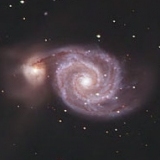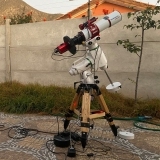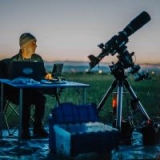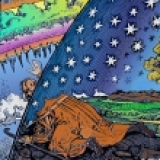INDI Library v2.0.7 is Released (01 Apr 2024)
Bi-monthly release with minor bug fixes and improvements
SEP Multistar best practices: Faster exposures?
- Rick Wayne
-
 Topic Author
Topic Author
- Offline
- Elite Member
-

- Posts: 222
- Thank you received: 20
SEP Multistar best practices: Faster exposures? was created by Rick Wayne
Seemed reasonable when I thought about it, though I've no idea how seeing affects multiple stars in a field. If they all waver in lockstep like a tiny tiny little dance routine, not much advantage. But if the stars wobble independently -- more like we Irish after bar time than a dance troupe -- then that could have a big impact.
So how does that work in SEP Multistar, pray? And what are the implications for guide camera exposure? If "chasing the seeing" is less of an issue, then I should be able to shorten the feedback loop considerably. The guider will still be driving by looking out the rearview, but it'll be looking at road the car just traversed, so less likely to charge through ditches scaring the frogs.
Please Log in or Create an account to join the conversation.
- Wouter van Reeven
-

- Offline
- Supernova Explorer
-

- Posts: 1957
- Thank you received: 420
Replied by Wouter van Reeven on topic SEP Multistar best practices: Faster exposures?
Please Log in or Create an account to join the conversation.
- Rick Wayne
-
 Topic Author
Topic Author
- Offline
- Elite Member
-

- Posts: 222
- Thank you received: 20
Replied by Rick Wayne on topic SEP Multistar best practices: Faster exposures?
Please Log in or Create an account to join the conversation.
- Hy Murveit
-

- Offline
- Administrator
-

- Posts: 1222
- Thank you received: 565
Replied by Hy Murveit on topic SEP Multistar best practices: Faster exposures?
It makes sense that it might help. If you wanted to go into it and look, you could turn on guide logging and see the various guiding offsets
of the different stars and see how they correlate. I know they differ from each other a bit.
Personally, I still guide at 3s, but experimenting with different guider timing certainly is worthwhile.
Hy
Please Log in or Create an account to join the conversation.
- Wouter van Reeven
-

- Offline
- Supernova Explorer
-

- Posts: 1957
- Thank you received: 420
Replied by Wouter van Reeven on topic SEP Multistar best practices: Faster exposures?
I am sorry but where in my reply did you read that? I merely tried to explain what seeing is and how stars are affected by it. I don’t know if shorter exposure times are beneficial when using SEP. As Hy wrote, give it a try and let us know.
Please Log in or Create an account to join the conversation.
- Rick Wayne
-
 Topic Author
Topic Author
- Offline
- Elite Member
-

- Posts: 222
- Thank you received: 20
Replied by Rick Wayne on topic SEP Multistar best practices: Faster exposures?
I'll be happy to give it a whack but as one guy with a somewhat overloaded CEM-25P who struggles to beat 1" RMS at the best of times, I doubt my experimentation will be of much value to the community.
Please Log in or Create an account to join the conversation.
Replied by Doug S on topic SEP Multistar best practices: Faster exposures?
www.cloudynights.com/topic/694739-autogu...imultaneously/page-2 (note that you should scroll down to comment #48...to view the most relevant material).
Whether or not our algorithm implementation has correctly averaged the independent contributions of multiple stars is a different matter. In principle however, a multistar guide algorithm should perform better with increasingly shorter exposures (assuming of course that SNR remains sufficient in those shorter exposures). For progressively longer exposures, seeing is of course being averaged out. Whether we can get exposures short enough to cross-over and outperform a long(er) exposure single star approach is TBD. Star constellation geometry and other factors will play roles too, so it's complicated (of course). In any case, it's a really interesting topic. The testing needed to drive out conditions/constraints where multi-star might outperform single star guiding would be interesting. This is good full-moon engineering time fodder!
Please Log in or Create an account to join the conversation.
- Rick Wayne
-
 Topic Author
Topic Author
- Offline
- Elite Member
-

- Posts: 222
- Thank you received: 20
Replied by Rick Wayne on topic SEP Multistar best practices: Faster exposures?
Here, I think it's more like Ben Goldacre's watchword. My astronomy motto could easily be "It's a little more complicated than that".
I suspect that in my particular instance, my mount tends to wander off and needs reining back in, very frequently. If I go with a long guide exposure, things have built up to Peak Ugly before the guiding yanks it back, but of course too short and it's just frenetically lunging in all directions.
Please Log in or Create an account to join the conversation.
- Scott Denning
-

- Offline
- Elite Member
-

- Posts: 300
- Thank you received: 57
Replied by Scott Denning on topic SEP Multistar best practices: Faster exposures?
I think the point is that when averaged together, the stars aren't jumping around so much so the guiding doesn't thrash like it does with a single star.
It might ALSO be better with shorter exposures, if indeed there are really fast errors in the mount. But that seems kind of speculative.
It seems to me that the reason we tend to use longer exposures for guiding is that we don't believe the short-term jumps are REAL. Rather, we think those very fast variations are from seeing and that we should just ignore them.
At any rate even with 3-second exposures my rms went down from about 1.2 arc seconds to about 0.6 arc seconds. I live immediately downwind of the Rocky Mountains so my seeing is notoriously bad, and I'm seriously impressed with the improvement from SEP Multistar guiding. It's the biggest guiding improvement I've ever seen.
Certainly seems to be a good research project. For a given night (to try to hold seeing constant), try a range of guide exposures with and without SEP multistar and see what happens!
Please Log in or Create an account to join the conversation.
- Wouter van Reeven
-

- Offline
- Supernova Explorer
-

- Posts: 1957
- Thank you received: 420
Replied by Wouter van Reeven on topic SEP Multistar best practices: Faster exposures?
Rrrright that’s another way of reading your question
Please Log in or Create an account to join the conversation.
Replied by alacant on topic SEP Multistar best practices: Faster exposures?
Hi
Until Hy's multistar and RA GPG, I always used PHD2's single star, which seemed better than anything EKOS could offer at the time.
Internal multistar reduces the FWHM of my images by at least 0.2 in comparison, and that's on a bad night. I found 2.5s to be the optimum guide frame exposure using a 60mm f4 guide telescope and 3.5s for an OAG at 1200mm. But hey, these are gut feelings, nothing scientific.
Are we now saying that shorter exposures are better?
Cheers
Please Log in or Create an account to join the conversation.
Replied by Doug S on topic SEP Multistar best practices: Faster exposures?
If you're referring to my post referencing shorter multistar exposures vs longer single star exposures, as I said, "it's complicated". The alignment/coverage/scale of the guide setup, geometry of the multistar constellation, star separations, SNR, the extent to which the mount is polar aligned, any oscillation behavior in the mount, etc., etc all play in the error budget. A well distributed, fast and bright multistar constellation should outperform a slower single star setup, especially for the simple case of poor mount alignment. In practice, there's likely to be one or more other issues in play, so bias errors could be adversely magnified. The answer to "go faster or slower" is likely going to be widely variable among users, and likely variable for the same user/gear on different targets and nights. That said, the anecdotal evidence being suggested by users thus far is pretty encouraging! I think experimenting a bit with exposure durations in the multistar config could be worth the effort. The "need" to go longer in singlestar (to average seeing) should now be reduced by multistar averaging. Cheers, Doug
Please Log in or Create an account to join the conversation.
